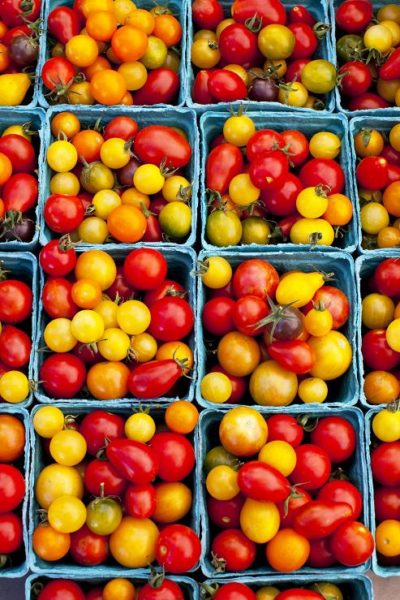They say the first step to recovery from addiction is admitting you have a problem. So here goes:
My name is Karen, and I buy too many vegetables out-of-doors.

Credit: istockphoto.com/Doug Berry
No, really. At home in Washington, DC, I can easily visit three or four farmers markets a week during the height of summer. My crisper drawer is full to overflowing. And even when I travel, I’m on the lookout for handmade signs hawking something, anything, at the peak of its season. In the last month, I have visited markets in Jackson, Wyoming, and Lansing, Michigan. Regretfully, I just missed one in Austin, Texas.
At that market in Michigan, I bought a quart of blueberries—a quart! of blueberries!—even though my hotel room had no mini-fridge and I had to cart them home on two planes, a bus, and a train the next day. (They arrived home mostly intact, to my husband’s delight.)
Clearly, I have a problem…
What is it about the idea of farmers selling directly to consumers that makes me a little weak in the knees? Well, there’s the ultra-fresh, ultra-nutritious produce and interesting variety (recently I bought bitter melon, a knobbly cucumber relative usually not seen outside Asia). And there’s the recipe-swapping and connection with my community. But now there’s evidence of something we can all get excited about.
Farmers markets = jobs
As the Union of Concerned Scientists’ latest report, Market Forces: Creating Jobs through Public Investment in Local and Regional Food Systems, points out, one of the most exciting benefits of farmers markets and other kinds of local food distribution channels is that they are job creators. As the author, my colleague and economist Jeff O’Hara, says:
The expansion of local and regional food systems supports employment, incomes, and output in rural communities. Direct marketing channels, such as farmers markets, stimulate rural economies because a greater percentage of the sales revenue is retained locally. Further, farmers may purchase equipment and raw materials from local suppliers. Such transactions increase labor and consequently household incomes, which result in additional spending.
And the benefits don’t just accrue to rural areas. The report also describes how farmers markets in cities and towns serve as community gathering places that attract consumers to downtown businesses.
It takes money to make money
Farmers markets are booming in the United States, more than doubling in numbers over the last decade to more than 7,000 markets nationwide. But all that growth has happened with relatively little help. Last year, for example, the USDA spent $13.725 billion in commodity, crop insurance, and supplemental disaster assistance payments mostly to support large industrial farms, according to the Congressional Budget Office.
The amount the agency spent that year to support local and regional food system farmers? Less than $100 million, according to U.S. Department of Agriculture (USDA) data.
O’Hara points out that, in its excessive emphasis on subsidies to Big Corn and the like, our farm and food policy isn’t doing us any favors:
If the U.S. government diverted just a small amount of the massive subsidies it lavishes on industrial agriculture to support these markets and small local farmers, it would not only improve American diets, it would generate tens of thousands of new jobs.
In particular, he calls for Congress to make greater investments through the USDA’s Farmers Market Promotion Program, estimating that it could create as many as 13,500 new jobs over five years by providing modest support to 100 to 500 otherwise unsuccessful farmers markets each year.
Beyond farmers markets
Last weekend, the New York Times suggested that in some urban areas, there are already so many farmers markets that farmers can’t keep up. Looking at the USDA’s map, it’s apparent that while that might be true in some places, there’s plenty of room for growth in others. And as Tom Laskawy points out over at Grist, what it means is that it’s time to move beyond reliance on weekly outdoor markets and develop more routes for getting locally produced foods into consumers’ hands.
To some extent this is already happening, with farmers markets magnifying their own impact by driving change within major grocery retailers. Just like the success of Whole Foods Market spurred more mainstream chains like Safeway to expand their organic product lines 10 years ago, it’s surely no accident that the rapid growth of farmers markets nationwide has been accompanied by new supermarket “buy local” initiatives. As The Packer recently noted, the Michigan-based Meijer grocery chain now purchases more than 75 items from 85 farmers in Michigan, Indiana, Illinois, Kentucky and Ohio, keeping about $60 million a year in that region.
Just think of the possibilities if Congress were to pass a farm bill in 2012 that made significant investments to expand local food systems nationwide. Write to your members of Congress today and encourage them to support farmers markets and local food initiatives by adding a local foods title to the next farm bill.
In the meantime, I’m going to skip the 12-step program and keep voting with my pocketbook.
